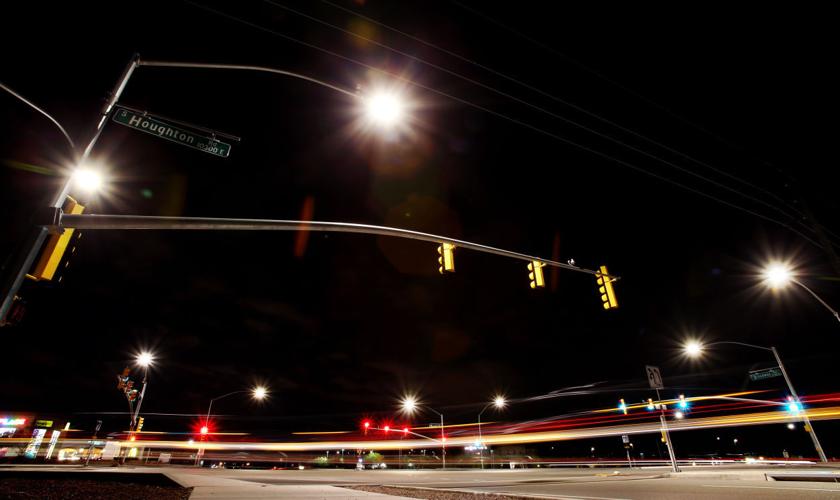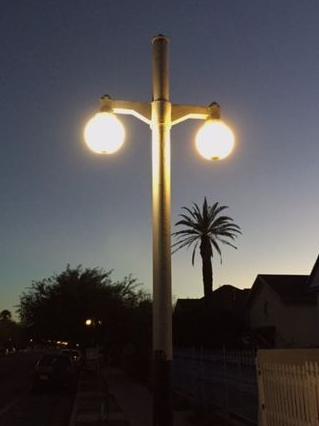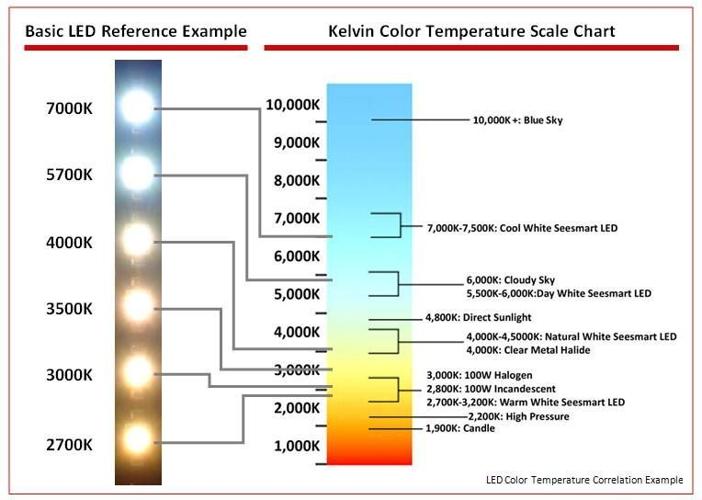Cities across the country are switching to bright, white LED lights in the name of safety, energy efficiency and cost savings — and getting grief from residents who don’t appreciate the daylight glare some LEDs produce.
In Tucson, where surrounding mountains are topped with telescopes, dim has always been in, and a city plan for converting to LEDs promises to take that into account.
City transportation officials say they can deliver better lighting that lowers cost without adding lumens to the city’s overall light pollution tally.
An energy audit conducted for the city by the vendor selling the lighting system says Tucson can save $180,000 a month on electrical costs while reducing the city’s overall lumens by 62 percent, said Jessie Sanders, projects manager in the Department of Transportation.
Sanders said the city will need to have a “community conversation” about the level of lighting it requires in various parts of town. The new lights will operate on a Wi-Fi network that will let the city dim, or even shut off lighting, where and when appropriate.
The City Council was briefed on the plan for an “investment-grade audit” of the city’s lighting in March and Sanders said he hopes to bring the now-completed results to the council for a decision early this year.
“We’re losing $180,000 a month for every month we delay this,” he said.
Councilman Steve Kozachik said he’s on board with the new plan after speaking with Steward Observatory Director Buell Jannuzi and verifying that the astronomers had been consulted on it.
“Protecting that asset (astronomy) is far more important than saving a few bucks on LED lighting,” Kozachik said.
The city awarded the energy audit to Ameresco, a global energy management firm with offices in three Arizona cities, including Tucson.
The city then hired lighting expert Christian Monrad, who designed the lighting systems for Arizona Stadium and Tucson International Airport, as its consultant. The LED lights at the airport are the same “color” as those the city expects to install.
Monrad, of Monrad Engineering, is on the board of directors of the International Dark Sky Association. He said Tucson, unlike many other cities, made quality of light and protection of astronomy key elements of the plan.
Ameresco was asked to balance the need to save money on lighting with the need to protect the area’s dark skies.
Some areas of town will still look a lot brighter, even though the LED lights are putting out fewer lumens, Sanders said.
Sanders said the new lights will be a little “bluer” than the more yellowish, high-pressure sodium lights now in use.
Less Watts, Less cost
The main problem with LEDs is the quality of light they produce. The most efficient LED fixtures produce light at the blue, shorter wavelengths of the electromagnetic spectrum — brighter than daylight and easily scattered, particularly in the dry climate of Tucson.
They can create glare and contribute to the sky-glow that threatens the future of astronomy.
Optical scientists measure the color composition of light on a Kelvin scale. The city specified 3,000-Kelvin fixtures — toward the “yellow” end of the scale.
Phoenix ran afoul of dark-sky proponents when it began conversion of its 95 thousand streetlights earlier this year to 4,000-Kelvin fixtures.
That plan was put on hold after installation of 400 new fixtures. Some cities, notably Davis, California, have replaced their LED lights after citizen complaints.
LEDs, or light-emitting diodes, have a lot going for them. They are efficient and long-lasting, producing more lumens per watt than most lighting sources. The three inventors of the energy-saving lights shared a Nobel Prize in Physics in 2014.
Tucson, for example uses 480 watts to light its high-pressure sodium streetlights. The LED equivalent will use 80 watts.
And Tucson can save more money by turning down the wattage.
Along the streetcar line, with its evening mix of walkers, bikers, drivers and transit riders, lights can be kept at full illumination.
In other parts of town, lights can be dimmed to a lower level earlier in the evening and possibly snuffed for sleeping. Monrad said all of the lights will be dimmed initially, then ramped up a tiny bit each year to keep the lighting consistent as dirt and grime build up.
That can’t be done with the current lighting, which he said starts out too bright in recognition of the fact that it will become dingy over time.
Dark Skies and Safe spaces
John Barentine, project manager at the International Dark-Sky Association, said the city is “going above and beyond” what his organization recommends.
“It’s progressive of Tucson to figure out how much light do we really need,” Barentine said. He has not been in contact with the city recently, but he said if officials are thinking of installing 3,000 Kelvin lights with adjustable controls, “that’s right in line with our recommendations.”
Jannuzi, director of Steward Observatory and the UA Department of Astronomy, said the astronomers “appreciate that the city is trying to find solutions that reduce the impact on what we do.”
The UA has telescopes on Kitt Peak, two peaks in the Santa Catalinas, Mount Hopkins in the Santa Rita Mountains and Mount Graham in the Pinaleños.
Jannuzi, a former Kitt Peak director, acknowledged the need to balance the competing interests of dark skies and safe spaces. “The astronomy community understands that people need light at night to be safe and to do activities that require being able to see.”
The audit recommendations, capped at $16 million, would replace 20,000 of the city’s 24,000 streetlights and the lighting in its parking garages.
The program’s cost would be financed, possibly by the vendor, and paid back through savings in electric bills. Sanders said the vendor, Ameresco, projects a monthly energy savings of $180,000.
Charlene Reynolds, deputy director of street transportation for the City of Phoenix, said that city originally went out to bid on lights at the 4,000-Kelvin level because that was the recommendation of the Dark-Sky Association at the time.
Jannuzi said the 4,000-Kelvin lights were a compromise, not a recommendation because the 3,000-Kelvin lights were 20 percent less efficient at the time. That gap has been narrowed, he said.
“What’s happening is that technology is developing faster than these procurement processes.”
Finding “the sweet spot”
Barentine said he would advise any city to slow down and investigate what’s available before plunging into a replacement program.
Tucson and Pima County have adopted a dark-sky lighting ordinance, in deference to the importance of astronomy to the region. A 2007 study, the most recent available, estimated it generated $250 million a year and employed 3,300 people in Arizona.
The code requires fully shielded lamps and limits total light produced by region, with the darkest regions in proximity to observatories and natural areas.
It has exceptions, including one for decorative lights in historic districts.
“Decorative lights caused us a number of problems in the audit,” said Sanders. In order to include them in the Wi-Fi network, they would need to be much taller, he said.
Sanders said bulbs in the historic lights are already being replaced, when necessary, with LED bulbs, but there is no plan to shield them or otherwise change their appearance. “You can’t do that in historic neighborhoods. People would come unglued.”
Lighting expert Monrad said the sum total of unshielded light from the city’s low-wattage historic fixtures is negligible or “lost in the noise” when the figures are totaled.
Monrad said LEDs got a bad rap when super-efficient, super-bright LED fixtures were sold like “snake oil” in recent years.
“Many cities have put in the most efficient LED lighting systems just to save as much energy as possible and resulting in aesthetically very poor, garish lighting,” Monrad said.
“3000 K is the sweet spot for a combination of aesthetics, energy savings and reduction in the blue-light content that adversely affects sky glow.”
The adverse effects aren’t limited to astronomy, he said.
“The human animal is really evolved to only expect and make good use of that color of light in daylight,” he said. “And it’s not just humans, but many physiological cycles in plants and animals.
“We all evolved under bright days and dark nights with moonlight and starlight.”






